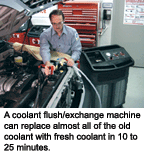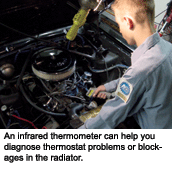It’s Getting Hotter Out There;
Know How to Keep Your Customers Cool
Coolant testers, pressure testers, flushers and exchangers. These are the tools and equipment shops need to keep their customers’ cooling systems cool. We’ve had an unusually hot summer this year. Record high temperatures across the country have left many vehicles steaming alongside the road. Yet many of these breakdowns could have been prevented with some basic cooling system maintenance. These include simple things like checking the coolant level, making sure the coolant is in good condition and is the right strength for hot weather, checking for leaks and flushing out the old coolant if a coolant change is needed.
 Many vehicles today have long-life coolants that have the potential of going up to five years or 150,000 miles. But these are not lifetime coolants. Eventually they wear out and must be replaced. To go the distance, the cooling system must be full, leak-free and in good working condition. The coolant must also contain adequate levels of corrosion inhibitor otherwise electrolytic corrosion will attack metal surfaces.
Many vehicles today have long-life coolants that have the potential of going up to five years or 150,000 miles. But these are not lifetime coolants. Eventually they wear out and must be replaced. To go the distance, the cooling system must be full, leak-free and in good working condition. The coolant must also contain adequate levels of corrosion inhibitor otherwise electrolytic corrosion will attack metal surfaces.
Coolant Testers
Color-coded chemical test strips that are dipped into the coolant can be used to quickly and easily reveal the condition of the coolant. These products react to the presence of certain dissolved minerals in the coolant, and change color to give a good, marginal or bad indication of the coolant’s condition. Some test strips also show the concentration of antifreeze in the coolant.
The strength of the coolant can also be measured with a hydrometer or an optical refractometer. A hydrometer uses a calibrated float or plastic balls to show the specific gravity of the coolant. This, in turn, shows how much freezing/boiling protection the coolant offers. For most applications, a 50/50 mixture of ethylene glycol antifreeze and water will provide freezing protection down to -34° F and boil-over protection up to 255° F with a 15 psi radiator cap.
The biggest danger during hot summer weather is having too much antifreeze in the coolant. Ethylene glycol does not absorb and carry heat as efficiently as water, so too much antifreeze may actually increase the risk of overheating. On the other hand, the coolant must contain some antifreeze because straight water boils at 212° F and provides no corrosion protection whatsoever.
If you are using a hydrometer to check the coolant, remember to compensate for temperature because the specific gravity (density) of the coolant is lower when the coolant is hot. Use a hydrometer with a calibrated glass float. The inexpensive coolant testers that use floating plastic balls are not as accurate. The best tool for this purpose is an optical refractometer because it is very accurate and automatically compensates for temperature. But a refractometer can cost up to $200 or more because of the precision optics in its lens.
Note: Ethylene glycol (EG) and polyethylene glycol (PG) antifreeze have slightly different densities, so you have to use a hydrometer or refractometer with the appropriate scale (or one with a dual scale) for accurate test results.
Pressure Testers
Leaks are a common cause of overheating. Coolant leaking from a hose, water pump, the radiator or the freeze plugs on the side of the engine can usually be seen. The real challenge is finding cooling leaks that can’t be seen because they are inside the engine (a bad head gasket or cracks in the cylinder head or block), in the heater core, or in the ATF heat exchanger inside the radiator. A weak radiator cap that can’t hold pressure may also allow a loss of coolant from the system.
 To check the integrity of the cooling system, a pressure tester is needed. This simple hand-held device uses a hand pump and an adapter fitting to pressurize the radiator and cooling system. If the system holds pressure, it is probably leak-free. If the system fails to hold pressure, and there are no visible leaks, additional checks will be needed to find the leak (inspecting spark plugs or the dipstick for signs of coolant contamination, checking compression, etc.).
To check the integrity of the cooling system, a pressure tester is needed. This simple hand-held device uses a hand pump and an adapter fitting to pressurize the radiator and cooling system. If the system holds pressure, it is probably leak-free. If the system fails to hold pressure, and there are no visible leaks, additional checks will be needed to find the leak (inspecting spark plugs or the dipstick for signs of coolant contamination, checking compression, etc.).
Infrared Thermometer
A noncontact infrared thermometer is another handy tool to have for cooling system diagnosis. An infrared thermometer can measure the temperature of any object by reading heat radiating from its surface. Hand-held infrared thermometers are relatively inexpensive (under $100) and are easy to use. Just point, squeeze the trigger and read the temperature in degrees F or C. Some even have a built-in laser pointer to show you where the tool is aimed.
This type of tool can be used to troubleshoot thermostats and coolant circulation. Aim the tool at the upper radiator hose or thermostat housing to check the opening temperature of the thermostat. The temperature reading should rise when the thermostat opens. No increase in temperature would tell you the thermostat isn’t opening.
The tool can also be used to scan the surface of the radiator. This can reveal cold spots due to internal blockages that are restricting coolant flow. The radiator should be flushed or replaced.
Coolant Flush/ Exchange Machines
When the coolant needs to be changed, it’s important to flush out all of the old coolant and to replace it with fresh antifreeze and water. A simple drain and fill is not a complete coolant change because up to half of the old coolant may remain trapped inside the engine block. It can also be a messy job if slippery antifreeze spills on the shop floor. On many vehicles, a drain and fill may also introduce air into the system that can be difficult to remove. Air trapped in the system may cause the engine to overheat.
To avoid these kinds of problems, a complete coolant exchange should be done using a coolant flush/exchange machine. The equipment connects to the radiator cap, and upper radiator hose or heater hoses with adapter fittings. Most are capable of replacing almost all of the old coolant (90 to 95%) with fresh coolant in 10 to 25 minutes. Automatic controls eliminate the need to babysit the equipment, and many machines include a pressure test to assure the integrity of the cooling system. The machine may be electric powered (12 volt DC or 110 volt AC) or pneumatic (125 psi shop air). Prices range from as low as $500 up to $1,700 or more depending on the features.
Because a coolant exchange machine is replacing liquid with liquid, air is kept out of the system so you don’t have to worry about air pockets that might cause the engine to overheat.
Many coolant exchangers also reverse flush the system to dislodge sediment, rust and scale as the coolant is being replaced. A pulsing action may be used to increase the effectiveness of the cleaning system. This also eliminates the need to flush the system with water, which takes extra time and creates additional waste and disposal issues.
Cleaning chemicals can be used with a coolant exchanger to clean dirty cooling systems. The chemicals are circulated through the system during the flush cycle to loosen rust and scale for better heat transfer and longer coolant life.
Coolant Recycling
If you’re concerned about used coolant disposal issues, a coolant recycling machine may be the way to go. This type of equipment filters the old coolant, adds chemicals to restore corrosion protection, and returns the rejuvenated coolant back to your customer’s vehicle. This type of equipment also offers increased profitability because you don’t have to buy any new coolant (except to top off systems that are low).
Some people are skeptical of coolant recycling because they don’t understand the process. Ethylene glycol, the main ingredient in most antifreeze, never wears out. But the chemical additives in the antifreeze that prevent corrosion are used up over time. The coolant can also become contaminated with rust and scale that forms inside the engine and radiator. Consequently, the coolant either has to be replaced, or filtered and rejuvenated with a fresh dose of chemicals.
Coolant recycling can be done a variety of ways, but most recycling machines use a filtration process and chemical reaction to remove contaminants. The coolant is pumped though a filter (sometimes more than once), and additional chemicals (flocculants) may be added to precipitate out other impurities such as emulsified oils and heavy metals. After filtering, an additive package and dye is added to restore the antifreeze.
The effectiveness of the cleaning process can vary from one type of recycling equipment to another. The corrosion inhibitor additives can also vary, so make sure the process meets the coolant requirements of the vehicle manufacturer.




